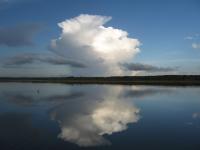
从尤卡坦半岛湖降雨记录中分析干旱
美国新一期《科学》杂志24日刊登的一篇研究报告显示,曾在墨西哥尤卡坦半岛和中美洲兴盛一时的玛雅文明的崩溃,可能与中等程度的干旱有关。
科学界长期以来一直怀疑,玛雅人历时100多年的缓慢衰败与周期性的干旱有关,但未能确认玛雅社会在崩溃前经历了多大程度的干旱。墨西哥尤卡坦科研中心和英国南安普顿大学研究人员分析了来自尤卡坦半岛的湖泊和石笋记录后发现,在公元800年至950年间的玛雅文明衰败期,由于夏季风暴减少,该地区降雨量曾不时地减少,有些降雨量减少的时期可长达10年,总体而言,玛雅社会经历的年度降水量比此前的正常期少大约25%至40%。这使该地区河流、湖泊等“开放水源”的蒸发量超过降水量。
研究人员表示,夏季是玛雅人耕作并对贮水系统进行补充的主要季节,而中等程度的降水减少就导致部分没有河流或其他水源的地区经历比较严重的水荒,“社会解体、城市被抛弃就成为水荒的可能后果,特别是因为持续多年的干旱频繁发生”。
玛雅文明是拉丁美洲古代印第安人文明,美洲古代印第安文明的杰出代表,以印第安玛雅人而得名。约形成于公元前2500年,主要分布在墨西哥南部、危地马拉、巴西、伯利兹以及洪都拉斯和萨尔瓦多西部地区。玛雅文明在物质文化、科学艺术等方面有很大成就。

 Collapse of Classic Maya Civilization Related to Modest Reduction in Precipitation
Collapse of Classic Maya Civilization Related to Modest Reduction in Precipitation
Martín Medina-Elizalde,Eelco J. Rohling
The disintegration of the Classic Maya civilization in the Yucatán Peninsula and Central America was a complex process that occurred over an approximately 200-year interval and involved a catastrophic depopulation of the region. Although it is well established that the civilization collapse coincided with widespread episodes of drought, their nature and severity remain enigmatic. We present a quantitative analysis that offers a coherent interpretation of four of the most detailed paleoclimate records of the event. We conclude that the droughts occurring during the disintegration of the Maya civilization represented up to a 40% reduction in annual precipitation, probably due to a reduction in summer season tropical storm frequency and intensity.
文献链接:https://www.sciencemag.org/content/335/6071/956.abstract







